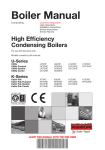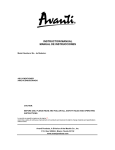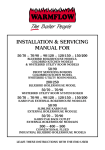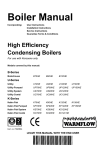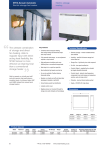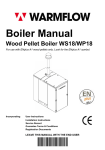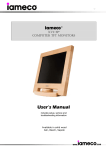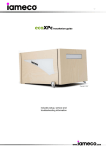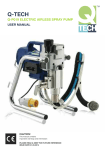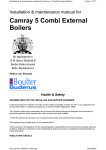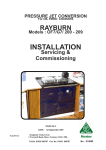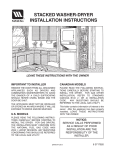Download WarmFlow COMBI 70 Technical data
Transcript
INSTALLATION & SERVICING MANUAL FOR 70/90 COMBI BOILER & 70/90 KABIN PAK COMBI LEAVE THESE INSTRUCTIONS WITH THE END USER BS 5750 ISO 9002 PART 2 I ST FI REG RM BSI E R ED NATIONAL ACCREDITATION OF CERTIFICATION BODIES CERT. No. FM 29884 ISSUE 4 MAR ’03 COMMISSIONING *THIS APPLIANCE MUST BE COMMISSIONED After commissioning ensure that the pre-paid warranty registration card is filled in and returned. SERVICING To ensure continued reliable operation and fuel economy it is recommended that the boiler is serviced annually. Warmflow Engineering Service division provides an excellent back-up service, operating a team of Oftec trained engineers who can meet all the servicing, commissioning and breakdown requirements for your appliance. Simply telephone TEL: (028) 9262 0852 FAX: (028) 9262 0869 E-MAIL: [email protected] *Failure to commission this appliance may invalidate warranty BEFORE FITTING THIS BOILER THE INSTALLER MUST CHECK: 1. What the maximum hot water demand is likely to be placed on the boiler. Not every installation is suitable for a Combi boiler. Systems requiring very high hot water flow rates may be better suited with an unvented cylinder. 2. That the mains are capable of supplying up to 24 litre/min with a minimum dynamic pressure of 1.8 bar at the boiler. This is to ensure that the boiler can achieve its maximum output. 3. The hardness of the mains water supply. Systems with hard water must be fitted with a suitable chemical scale preventer (eg Fernox Quantomat or Combimate alternatively contact Warmflow for further details). 4. That the flow from any one hot water outlet does not exceed the maximum recommended. This applies particularly to baths which are usually fitted with larger taps and larger bore supply pipes. It may be necessary to restrict the flow to these taps by reducing the bore of the supply pipework or by fitting a restrictor into the pipework. 5. That any outlet when opened does not starve all the other outlets of hot water. If more than one outlet is open at the same time then the total flow from all the outlets should not exceed the maximum flow rate of the boiler. 6. That any showers being supplied hot water by the boiler are compatible with this type of appliance. It should be noted that the boiler has been factory fitted with an 18 litre/min flow restrictor. The manufacturers guarantees are void if the appliance is not installed and commissioned in accordance with the recommendations made herein. Page 1 Contents Page 1.0 User Instructions ................................................................................................................. 3 1.1 Introduction ................................................................................................................. 4 1.2 General Requirements ................................................................................................ 4 1.3 Components................................................................................................................ 5 2.0 Technical Details .................................................................................................................. 7 2.1 Sequence of Operation Flow Chart............................................................................. 7 2.2 Baffles ......................................................................................................................... 8 2.3 General Requirements ................................................................................................ 8 2.4 Dimensions ................................................................................................................. 9 2.5 Combi Flue Options .................................................................................................. 10 2.6 Technical Data .......................................................................................................... 13 3.0 Electricity Supply ............................................................................................................... 14 3.1 RDB Burner Control Box ........................................................................................... 14 3.2 Fitting a Room Thermostat ....................................................................................... 14 3.3 Combi Wiring Details ................................................................................................ 15 3.4 Kabin Pak Combi Wiring Details ............................................................................... 17 3.5 Frost Thermostats ..................................................................................................... 19 3.6 Timers for Standard Combi ....................................................................................... 20 3.7 Timers for Kabin Pak Combis ................................................................................... 22 4.0 Oil Supply ........................................................................................................................... 23 4.1 One Pipe System ...................................................................................................... 23 4.2 Two Pipe System ...................................................................................................... 24 4.3 De-aerator System .................................................................................................... 24 4.4 One Pipe Lift ............................................................................................................. 25 5.0 Flues .................................................................................................................................. 26 5.1 Conventional Flues ................................................................................................... 26 5.2 Low Level Discharge/Low Level Balanced Flues Terminal Position ......................... 26 6.0 Air Supply for Combustion and Ventilation ..................................................................... 28 6.1 Open Flue Boilers ..................................................................................................... 28 6.2 Balanced Flue Boilers ............................................................................................... 28 6.3 Installation of Flues ................................................................................................... 29 7.0 Thermostat Control Knob Peg Setting ............................................................................. 31 8.0 Installation .......................................................................................................................... 32 8.1 Hearth ....................................................................................................................... 32 8.2 Service Access.......................................................................................................... 32 8.3 Heating System......................................................................................................... 32 8.4 Domestic Hot Water .................................................................................................. 34 8.5 Removal of Flow Restrictor ....................................................................................... 34 8.6 Fitting a Vertical Flue Adaptor ................................................................................... 35 8.7 Installation of Air Intake Duct .................................................................................... 35 9.0 Burners ............................................................................................................................... 36 9.1 RDB Burner............................................................................................................... 36 9.2 Oil Supply.................................................................................................................. 36 9.3 Electrical Connections .............................................................................................. 37 9.4 Electrode Setting....................................................................................................... 37 9.5 Burner Start-up Cycle ............................................................................................... 37 10.0 Commissioning and Servicing ......................................................................................... 38 10.1 Commissioning ......................................................................................................... 38 10.2 Servicing ................................................................................................................... 38 11.0 Horstmann 626 Electronic Programmer .......................................................................... 39 12.0 Fault Finding ...................................................................................................................... 44 12.1 Central Heating ......................................................................................................... 44 12.2 Domestic Hot Water .................................................................................................. 45 12.3 Burner ....................................................................................................................... 46 13.0 Spares ................................................................................................................................. 47 13.1 Riello RDB Burner..................................................................................................... 47 13.2 Pipe Spares .............................................................................................................. 48 13.3 Short Parts List ......................................................................................................... 49 Page 2 1.0 User Instructions 1.0.1 Boiler Control Thermostat The boiler control thermostat is located on the front of the boiler facia panel and may be adjusted from 52°C to 85°C. The recommended minimum thermostat setting is 65°C. Below this ‘cold water corrosion’ is likely to occur thus reducing the life of the heat exchanger and is not covered by the manufacturer’s warranty. When using hot water only it is recommended that the boiler control thermostat is switched to the off position. 1.0.2 Mains Indicator The green mains light will be lit when there is power to the control panel. 1.0.3 H/L Reset The yellow H/L reset lamp will be lit when the high limit thermostat has tripped at its set temperature of 110°C. This cuts off power to the burner and may indicate that there is a fault in the heating system. The high limit thermostat has a manual reset button located underneath the control panel in line with the control thermostat. Once the temperature has fallen and the reset button has been pressed the boiler should restart. If the high limit thermostat continues to trip contact your service engineer/technician. 1.0.4 Lock Out The red lock out lamp will be lit when the burner has failed and can be reset by pressing the illuminated red reset button on the burner control box. If there is power and the thermostat is calling for heat and the burner has been reset it will go through its start up cycle. If the burner again fails to fire this would indicate a burner fault or oil supply problem (oil supply problems are not covered by manufacturers warranty). 1.0.5 Tank Control Thermostat Located on the right hand side of the control panel the tank control thermostat controls the temperature in the thermal store. The temperature is adjustable up to a maximum of 80°C. A peg has been fitted to the rear of the knob to prevent the temperature being set too high. To change the setting see page 31. 1.0.6 Tank Limit Thermostat Located inside the control panel the tank limit thermostat is a thermal resetting device controlling the on/off operation of the burner in hot water mode. 1.0.7 Hot Water and Central Heating On/Off Switch Both hot water and central heating operations can be controlled via these switches. However it should be noted that when both switches are in the ‘on’ position hot water will have priority. In addition whenever a timer or programmer is connected to the boiler one or more of these switches may be bypassed. 1.0.8 Pressure Gauge The pressure gauge fitted to the front of the control panel measures system pressure. The pressure should be set at 1 bar when the boiler is cold. As the boiler heats up, the pressure will rise but should not exceed 3 bar. 1.0.9 Servicing It is recommended that the boiler is serviced annually by an OFTEC registered engineer. Page 3 1.1 Introduction Note: All our domestic appliances have been independently tested and accredited as exceeding the minimum SEDBUK efficiency levels required for its type, in compliance with the Building Regulations Approved Document L1 2001 for England and Wales and the Building Standards (Scotland) Regulations 2001 Part J. The Warmflow oil fired ‘Combi’ boiler and Kabin Pak Combi are suitable for sealed central heating systems and can provide at mains pressure domestic hot water without the use of a cylinder. The Warmflow oil fired combis are designed to burn Class C2 (28 sec redwood) kerosine or Class D (35 sec redwood) gas oil. However to comply with building regulations only kerosine may be burned when using the low level balanced flue or low level conventional flue. As standard the appliance is fitted with a system expansion vessel, circulating pumps, filling loop, pressure gauge and safety valve. An optional 7-day electronic programmer is also available. The pressure jet oil burner is covered by the manufacturer’s parts and labour warranty valid for one year (from the boiler date stamp). The boiler and heat store are covered by a manufacturer’s warranty of 5 years (from the boiler date stamp) but does not include burner, labour, handling or shipping. Details of any extended warranties are contained within the installation pack. Optional extended guarantees, for the appliance covering parts and labour of up to 5 years initially are also available (although not applicable to the Republic of Ireland). The manufacturer’s guarantees are void if the appliance is not installed and commissioned in accordance with the recommendations made herein. 1.2 General Requirements The installation of the boiler must be in accordance with the following regulations. BS5410 : PART 1 : 1997 Code of practice for oil firing. BS5449 : PART 1 : 1997 Forced circulation hot water systems. BS7593 : 1992 Treatment of water in domestic hot water central heating systems. Current Building Regulations: Part J England and Wales Part F Scotland Part L Northern Ireland Current IEE Regulations: BS7074 : PART 1 : Application Selection & Installation of Expansion Vessels The heating system should be installed by a competent installer in accordance with the recommendations laid down by HVCA, OFTEC and a sound engineering practice. In order to comply with GB building regulations OFTEC forms CD10 for installations and CD11 for commissioning should be left with the customer. Page 4 1.3 Components 1.3.1 Combi Assembly 8 9 1 10 11 12 2 13 14 3 4 15 5 16 17 6 18 7 1. 2. 3. 4. 5. 6. 7. 8. 9. Automatic Air Vents Boiler Heat Exchanger Boiler Control and Limit Stat 12 Litre Esxpansion vessel Boiler Data Plate RDB Burner Boiler Drain Valve Pressure Relief Valve Strainer 10. 11. 12. 13. 14. 15. 16. 17. 18. Filling Loop Tank Control and Limit Stat Flow Switch Mixer Valve Plate Heat Exchanger CH Pump Head DHW Pump Head Pump Gate Valves (x3) Tank Drain Valve 1.3.2 Combi Control Panel BOILER CONTROL THERMOSTAT CH PUMP MAINS ON LAMP (GREEN) HIGH LIMIT TRIPPED LAMP (YELLOW) TANK CONTROL THERMOSTAT BLANKING PLATE BURNER LOCKOUT LAMP (RED) DHW PUMP HIGH LIMIT THERMOSTAT RESET (UNDERNEATH) Page 5 CH ON/OFF SWITCH SYSTEM PRESSURE GAUGE 1.3.3 Kabin Combi Assembly 1 2 3 4 5 6 24 7 23 8 22 21 9 20 19 10 11 1. 2. 3. 4. 5. 6. 7. 8. Flue Terminal Guard Low Level Flue Service Access Hatch Control Panel Cover Controls Pressure Vessel Control Panel Flap Lock Control Panel Flap 9. 10. 11. 12. 13. 14. 15. 16. 12 13 14 16 15 17 Door Panel Burner Reset Burner Reset Button Burner Return Connection DHW Pump CH Pump Cable on Oil Line Grommets 18 17. 18. 19. 20. 21. 22. 23. 24. Air Intake Grill Pipe Access Hole Plate Heat Exchanger Mixing Valve Side Panel Pipe Entry Grommets Auto Air Vent Pressure Relief Valve Note: To convert the Kabin Pak for use with a conventional flue use the Kabin Pak adaptor (KPA). 1.3.4 Kabin Pak Combi Control Panel High Limit Thermostat Reset Mains On (Green) Tank Control System Thermostat Pressure Gauge CH Pump High Limit (Yellow) Burner Lockout (Red) DHW Pump Boiler Control Thermostat DHW ON/OFF Switch Page 6 CH ON/OFF Switch 2.0 Technical Details 2.1 Sequence of Operation Flow Chart NO Power On NO YES Timer Calling For Heat YES NO HW Selected YES Flow Switch Closed YES NO YES DHW Tank Stat Satisfied NO HW Limit Stat Tripped CH Selected NO YES Boiler Limit Stat Tripped NO Boiler Stat Satisfied NO Press Reset Button YES Boiler Limit Stat Tripped NO YES Burner Fires Burner Stops YES Press Reset Button NO CH Pump Only Runs YES YES NO Room Stat Satisfied YES DHW Pump Only Runs Burner Fires The boiler will have a DHW priority when both domestic hot water (DHW) and central heating (CH) are selected. So if the flow switch is closed or the heat store has not been satisfied the entire output of the boiler is directed to DHW before the boiler will switch over to CH. When fully cold it can take up to 20 minutes for the heat store to be satisfied. After a draw-off of 120L at 24L/min, with an average temperature rise of 32°C, the thermal store has a recovery time of approximately 7 mins. Note: If HW has not been selected no hot water can be produced even if the heat store is up to temperature. Page 7 2.2 Baffles FRONT Before firing make sure the baffles have not been dislodged in transit and are correctly positioned. To achieve maximum efficiency push the baffles in the direction of the arrows as shown. 2.3 General Requirements 1. The Warmflow Combi is supplied with all the necessary components for a sealed heating system. However, on some larger systems with a total water content greater than approx 150L, an expansion vessel, in addition to the integral 12L vessel supplied, may be required. 2. The pressure relief discharge shall be positioned away from any electrical components. No other valves should be positioned between the relief valve and the discharge, and the discharge pipe should not be used for any other purposes. The discharge pipe must be plumbed to an external drain in a position where the discharge can been seen but cannot cause any injury or damage. 3. Where there is a catastrophic loss of water from the system the boiler thermostats may fail to operate which would result in serious damage to the appliance. To prevent this it is recommended that a low pressure cut out switch set at 0.2 bar is fitted to the system and wired in series with the boiler limit thermostat. 4. The boiler should be stored in a dry environment. No heavy objects should be placed on top of the boiler. Where possible the boiler should be moved on its pallet or trucked from its rear. Manhandling the boiler by its casings will result in damage and must be avoided. Page 8 2.4 Dimensions 2.4.1 Combi Dimensions B K J L C H A G F D E MODEL A B C D E F G H J K L 70/90 865 595 595 90 59 554 750 125 127 127 203 2.4.2 Combi Boiler Connections 1620 1310 820 460 1 2 3 4 8130 8000 8045 5 6 REAR VIEW All dimensions are given in mm. 1. 2. 3. Cold Mains (15mm) Heating Flow (22mm) Domestic Hot Water (22mm) 4. 5. 6. Page 9 Pressure Relief Discharge (15mm) Spare Connection (1” BSP) Central Heating Return (1” BSP) 2.4.3 Kabin Pak Combi Dimensions H E J G F D A B 2.5 C MODEL A B C D E F G H J 70/90 892 732 636 373 188 191 376 172 371 Combi Flue Options (not applicable to the Kabin Pak Combi) Note: Low level flue options are rear or left hand outlet only. 2.5.1 ‘Easy Fit’ Telescopic Low Level Balanced Flue (BF-R) The horizontal dimension can be increased up to an additional 1200mm using a combination of long extension pieces (E600 = 600mm) and short extension pieces (E300 = 300mm). 102 Ø125 225 MAX 175 MIN 712 MAX 490 MIN Page 10 2.5.2 ‘Easy Fit’ High Level Balanced Flue (HLBF) The HLBF is available in 4 fixed horizontal lengths which are: SEE OPTIONS Option 1 – 455mm 160x160 Option 2 – 655mm Option 3 – 585mm Option 4 – 785mm 1128 225 MAX 175 MIN 2.5.3 ‘Easy Fit’ Telescopic Low Level Conventional Flue (LLF-R) 102 Ø125 155 MIN 225 MAX 792 MAX 540 MIN 2.5.4 Standard Low Level Conventional Flue (LLF) The factory supplied elbow may be extended up to 1m horizontally and 1.5m vertically by welding on additional pipe or by using vitreous enamelled flue pipe. 102 155x155 155 MIN 225 MAX 575 Page 11 AVAILABLE FROM SPRING 2003 2.5.5 Easy Fit Telescopic High Level Balanced Flue (HLBF-R) A EXTENSION KITS AS REQUIRED (PACKS C OR D) PACK E OR F PACK E OR F 175 MIN 225 MAX ALL MODELS DIM A FLUE PACKS MIN MAX 435 610 A+E 560 860 A+F 735 910 A+C+E 1570 MIN 2070 MAX 50/70, 70/90 & 90/120 MODELS ONLY PACK A DIM A FLUE PACKS MIN MAX 860 1160 A+C+F 1035 1210 A+C+C+E 1160 1510 A+C+C+F 1385 1560 A+D+E 1510 1860 A+D+F 2.5.6 Easy Fit Vertical Balanced Flue (VBF) 675mm MIN 675mm MIN PACK H PITCHED ROOF FLASHING (22" – 45" ADJUSTABLE) PACK G FLAT ROOF FLASHING PACK B VBF TERMINAL SECTION PACK B VBF TERMINAL SECTION EXTENSION KITS (PACK C OR D) AS REQUIRED MAX 2 NO PACK D ALL MODELS FLUE HEIGHT PACK A FLUE PACKS MIN MAX 1340 1840 A+B 1640 2140 A+B+C 1940 2440 A+B+C+C 2290 2740 A+B+D 2590 3040 A+B+D+C 2890 3340 A+B+D+C+C 3240 3740 A+B+D+D Note: When using a VBF or HLBF-R on a 120/150 or 150/200 model ensure that the boiler is fitted with a RDB3 burner. Page 12 2.6 Technical Data 70/90 Combi Model Nominal heat Input Nominal heat Output Efficiency at max output (net) KW Btu/hr KW Btu/hr % Burner Head Flue mm 70/90 Kabin Pak Combi 29.3 29.3 100,000 100,000 26.4 26.4 90,000 90,000 90 90 RDB 1 RDB 1 LD3 LD3 100 or 127 Integral Size in 4 or 5 Low Level Max CO2 % 11.5-12.0 11.5-12.0 0-1 0-1 °C 235 235 mbar 12.0 12.0 l/h 3.15 3.15 Flow rate gals/h 0.69 0.69 Nozzle make DANFOSS 60°S DANFOSS 60°S (kerosine) size 0.75 0.75 Pump bar 8 8 Pressure psi 116 116 Smoke FGT at max output Water resistance at 20°C ∆T Approx fuel Nozzle make DANFOSS 60°S DANFOSS 60°S (gas oil) size 0.6 0.6 Pump bar 12 12 Pressure psi 175 175 Dry weight kg 155 155 L 70 70 Min inlet dynamic pressure bar 1.8 1.8 for max hot water flow psi Primary water content Max DHW flow rate achievable (refer to page 1) Factory set DHW flow rate Min DHW flow rate DHW temp rise °C Pressure Relief 26 26 Unrestricted Unrestricted 24 l/min (5.3 gals/min) recommended 24 l/min (5.3 gals/min) recommended 18 l/min (4.0 gals/min) 18 l/min (4.0 gals/min) 2.5 l/min (0.55 gals/min) 2.5 l/min (0.55 gals/min) 32°C @ 24 L/min for 120L draw off 32°C @ 24 L/min for 120L draw off 3 bar (43.5 psi) 3 bar (43.5 psi) Heating flow 22 mm 22 mm Heating return 1” BSP 22 mm Comp. DHW outlet Cold water mains inlet (refer to page 1) Ingress Protection 22 mm 22 mm Unrestricted 15 mm bore (minimum) Unrestricted 15 mm bore (minimum) IPX0 IP45 Page 13 3.0 Electricity Supply 220 - 240V. 1PH, 50 Hz The boiler/burner and other external electrical equipment should be wired via a fused double pole isolating switch which should be fitted with a 5 amp fuse. In order to ensure the safety of the Kabin Pak Combi Warmflow recommends that power to the appliance is supplied through a suitable CE approved RCD trip switch. The appliance must be effectively earthed and all external wiring should comply with current IEE Regulations. It is the responsibility of the installer to ensure that the appliance has been properly earthed. Earth Neutral Live RDB Burner Control Box Lock Out 3.1 CONTROL BOX 535SE/LD Fan Housing M Photoresistance Motor Black White Blue Oil Valve M Capacitor 3.2 Fitting a Room Thermostat PCB 26 27 28 29 30 N 5 ROOM THERMOSTAT Remove the purple wire from no 5 and no 28 on the PCB and wire the thermostat as shown. The room thermostat should be located where it is not subjected to extraneous heat gains, direct sunlight or draughts. Page 14 P O Y R W BR BL B G/Y 3.3 3.3.1 Wiring Diagram – Purple – Orange – Yellow – Red – White – Brown – Blue – Black – Green/Yellow Combi Wiring Details Page 15 BREAK INTO THE WHITE WIRE BETWEEN NO 16 ON THE PCB AND THE LIMIT STAT AND CONNECT IN THE PRESSURE SWITCH WITH A WIRING BLOCK AS SHOWN 3.3.2 Combi Wiring Schematic Page 16 P O Y R W BR BL B G/Y GY 3.4 3.4.1 Kabin Pak Combi Wiring Diagram Page 17 – Purple – Orange – Yellow – Red – White – Brown – Blue – Black – Green/Yellow – Grey Kabin Pak Combi Wiring Details BREAK INTO THE WHITE WIRE BETWEEN NO 16 ON THE PCB AND THE LIMIT STAT AND CONNECT IN THE PRESSURE SWITCH WITH A WIRING BLOCK AS SHOWN 3.4.2 Kabin Pak Combi Wiring Schematic Page 18 3.5 Frost Thermostats 3.5.1 Combi Boilers The switched live from the frost thermostat (the frost thermostat must be supplied by a permanent live) should be connected to number 5 on the boiler terminal block. In order to protect the fabric of the building as well as the boiler and pipework, the thermostat should be located in the coldest part of the house but where it can respond to any temperature rise. FROST THERMOSTAT PERMANENT LIVE 3 4 5 6 3.5.2 Kabin Pak Combi Boilers As the boiler is supplied with a factory fitted frost thermostat all that is required is for a permanent live to be supplied to the control panel. Page 19 3.6 Timers for Standard Combi Note: Single channel timers or programmers are not recommended. 3.6.1 Installation of a remote two channel programmer (option 1) Remove the purple wire connecting 5 and 28 and the white wire connecting 3 and 19. Connect the programmer as shown via a fused isolator. E This bypasses the central heating and hot water on/off switch. N L CH HW COM COM OFF ON OFF ON 12 11 If the connection to terminal 12 is not made the mains on lamp is also bypassed. EARTH POST 28 27 26 25 A separate live supply to the boiler is not required. However a neutral and earth must be supplied to the boiler. 24 22 23 21 20 19 PCB CONTROLLER 3.6.2 Installation of a remote two channel programmer (option 2) Remove the purple, white and brown wires connecting the central heating and hot water on/off switches to the 6 pin male plug. Connect the programmer as shown. The mains is supplied via a fused isolator to the boiler 3 pin mains plug. E N L CH HW COM COM OFF ON OFF ON 1 2 3 4 5 6 EARTH POST Page 20 3.6.3 Installation of Warmflow Optional Programmer (not applicable to the Kabin Pak Combi) 1. Disconnect the electrical supply. 2. Remove top casing (4 studs) and control box cover (1 screw). 3. Remove 2 screws securing blanking plate/programmer bracket. Remove bracket and blanking plate from the control panel. 4. Disconnect the blanking plate from bracket (2 screws). 5. Feed programmer harness through the hole in the bracket. The programmer is secured to the bracket with 2 screws. 6. Disconnect the 6 pin plug from the CH and HW on/off plugs. 7. Connect the programmer 6 pin plug into the socket. 8. Locate the programmer into the hole in the facia and secure the bracket to the control panel (2 screws). 9. Set the time switch on the rear of the programmer to ‘G’ or ‘P’ (see programmer instructions). 10. Replace the control panel cover and reconnect electrical supply. 11. Operational instructions are included in this handbook. (Section 11, Page 27) OPITIONAL PROGRAMMER BLANKING PLATE/ PROGRAMMER BRACKET BLANKING PLATE CONTROL PANEL Page 21 3.7 Timers for Kabin Pak Combis Note: Single channel timers or programmers are not recommended. 3.7.1 Installation of a Remote Two Channel Programmer THE HW AND CH SELECTOR SWITCHES ON THE BOILER CONTROL PANEL SHOULD BE LEFT IN THE OFF POSITION BUT CAN BE USED AS SERVICING SWITCHES TO TURN THE BOILER ON EVEN WHEN THE CLOCK IS OFF L N E R C D E N L HW CH COM COM OFF ON OFF ON 5 3 ISOLATOR TO BE FITTED WITHIN BOILER CASING BOILER MAINS PLUG Page 22 4.0 Oil Supply 1. Oil Tank Steel tanks constructed to BS 799 Part 5 1987 should be painted on the outside only and mounted on piers to prevent corrosion. Plastic oil tanks are also available and can be suitable for installation at ground level. However, oil should never be stored in translucent plastic containers. The tank outlet should be at a height to provide sufficient clearance to allow for proper maintenance of any isolation valve oil filter or water separator fitted. 2. The pipe from the oil tank to the burner should be run in copper, steel or aluminium pipework. Galvanised pipe and fittings should not be used. The pipework should terminate close to the boiler and be fitted with an isolating valve and filter. It is also recommended that a remote sensing fire valve should be fitted to the oil line preferably before the oil line enters the building (BS5410 : PART 1). Where a fire valve is fitted to a Kabin Pak Combi the valve body must be situated at least one metre away from this appliance. Depending on the position of the tank a two pipe system may be required. One and two pipe oil systems are shown below. As an alternative to a two pipe system a Tigerloop or other approved de-aerator. may be used. 4.1 One Pipe System 20mm PER METRE SLOPE WATER SEPARATOR Total Maximum Pipe Length (m) Head H(m) 0.5 1 1.5 2 I.D. 8 mm I.D. 10 mm 10 20 40 60 20 40 80 100 Note: Plastic oil level gauges may shrink when exposed to kerosene thus allowing the ingress of water. Pump failures due to water contamination are not covered under the warranty. Page 23 4.2 Two Pipe System APPROVED SITE GAUGE 20mm PER METRE SLOPE WATER SEPARATOR Total Maximum Pipe Length (m) 4.3 Lift H(m) 0.5 I.D. 8 mm I.D. 10 mm 35 100 1 1.5 2 30 25 20 15 8 6 100 100 90 70 30 20 0.5 3 3.5 De-aerator System FIRE VALVE SENSOR DE-AERATOR MAY BE ABOVE OR BELOW BURNER AND MUST BE POSITIONED OUTSIDE FILTER MAY BE POSITIONED OUTSIDE APPROVED SITE GAUGE PLASTIC TANK SHOWN STEEL TANK ALSO SUITABLE NONRETURN VALVE FIRE VALVE DE-AERATOR Must be upright FILTER ‘T’ & TAP FOR DRAIN SHUT OFF VALVE For maximum pipe length and lift contact de-aerator manufacturer. Page 24 4.4 One Pipe Lift APPROVED SITE GAUGE Note: The pump vacuum should not exceed a maximum of 0.4 bar. Above this gas is released from the oil thus leading to burner lock out. 20mm PER METRE SLOPE WATER SEPARATOR Total Maximum Pipe Length (m) Lift H(m) 0.5 0.5 1 1.5 2 3 3.5 ID 8mm 35 30 25 20 15 8 6 ID 10mm 100 100 100 90 70 30 20 Page 25 5.0 Flues 5.1 Conventional Flues The flue should be designed in accordance with the local bye-laws and the Clean Air Act. Draught stabilisers are not recommended for oil fired boilers. Sharp bends or horizontal runs should be avoided and the flue should terminate 2 feet (600 mm) above the ridge of the dwelling. Terminals which restrict the discharge or allow ingress of water should be avoided. It is recommenced that when connecting to an existing masonry chimney a flexible stainless steel liner of the correct diameter should be used. The annular space must be sealed top and bottom and filled with insulation. 5.2 Low Level Convert/Low Level Balanced Flues Terminal Positions and Kabin Pak Flues Attention should be given to the position of the flue discharge; we recommend the following guidelines be adopted. 1. The flue should not discharge beneath opening windows or within 2 metres of other accesses to the building. 2. The flue should not discharge near internal/external corners of the building where turbulent wind conditions could occur. 3. A terminal guard should be fitted at all times. 4. The terminal should not discharge over property boundaries. 5. Discharge into narrow passageways should be avoided. 6. The actual siting of the flue should be determined by the installer after consultation with the householder. 7. In positioning this flue the wind direction should be considered. Installation in exposed positions is not recommended. Page 26 Terminal Position A B C D E F G H I J K Min Distance Below gutters, soil pipes or drain pipes From a door, window or air vent Above ground, flat roof or balcony level Below eaves or balconies From an internal or external corner From a terminal facing the terminal From a surface facing the terminal Vertically from a terminal on the same wall Horizontally from the terminal on the same wall Directly below an opening, air brick, window, etc. From a vertical drain pipe or soil pipe 1000 600 600 1000 600 600 600 1500 600 600 1000 These are minimum dimensions and are only quoted as a guideline but they will satisfy the requirements of all UK Building regulations. Where the flue terminal is within 1 metre of any plastic material, such material should be shielded from the effects of the combustion products of the flue. Page 27 6.0 Air Supply for Combustion and Ventilation (see BS 5410) 6.1 Open Flue Boilers When the boiler is sited in a cellar where the only access for combustion and ventilation air is at high level then the combustion air should be ducted to low level. Combustion Air Supply Boiler in Room Boiler in Compartment 6.2 Balanced Flue Boilers in a Compartment Air Supply for Ventilation No Combustion Air Inlet required to Room Page 28 6.3 Installation of Flues TOP PANEL BLANKING PLATE Easy Fit High Level Balanced Flue (HLBF-R) OPTIONAL FLUE DRESSING RING FLUE TERMINAL TOP PANEL OPTIONAL EXTENSION PIECES FLUE GASKET HORIZONTAL FLUE ADAPTOR TEST HOLE PLUG CONVENTIONAL FLUE RING Easy Fit Vertical Balanced Flue (VBF) BOILER LID AIR INTAKE ADAPTER SPIGOT & GASKET AIR INTAKE COVER Easy Fit High Level Balanced Flue (HLBF) RIELLO RDB BURNER Easy Fit Balanced Flue (BF-R) Standard Low Level Conventional Flue (LLF) Easy Fit Low Level Conventional Flue (LLF-R) Page 29 6.3.1 Installation of a Balanced Flue (BF-R, HLBF-R & VBF) 1. Make a suitable sized hole in the wall or ceiling for the flue kit. Add the dimensions given on pages 6 (Dimension G) and 8 (Flue Vertical Dimension). The cavities around the opening must be sealed and protected by a non-combustable sleeve. 2. Remove the top panel (kitchen and utility models) and the combustion chamber lid. 3. Remove the flue ring from the top of the boiler (3 screws) ensuring that any remaining silicone sealant has been cleaned away. 4. Carefully fit the inner and out seals to the flue adaptor. Note: After fitting the seals to the flue smear them with soap or any suitable lubricant which does not react with the silicone rubber. 5. Place the gasket correctly on the boiler and locate the flue adaptor over this, fixing it in position using the nuts and bolts provided. For BF-R side outlet options on white case boilers it will be necessary to manoeuvre the adaptor through the side panel before fixing it to the boiler after the blanking plate has been removed. Push boiler into position against the wall. 6. If fitting extension pieces ensure the seals are correctly fitted and lubricated before pushing through the wall and attaching to the flue adaptor. Note: Any combination of short (300mm) and long (600mm) extension pieces for the BF-R can be used up to a maximum additional length of 1200mm. 7. Slide the flue terminal into position with a twisting movement ensuring that it protrudes through the wall by a minimum of 175mm and a maximum of 225mm or through the roof by a minimum of 665mm. 8. Seal the gap between the flue and the wall both inside and out after which the protective basket must be fitted to the wall over the flue terminal. 9. After removing the air inlet cover fit the air intake adaptor spigot and gasket to the burner. Connect one end of the air duct to the flue and the other end to the air intake spigot on the burner. Both ends should be securely fastened with the jubilee clips. 10. The boiler is now ready to be connected to the plumbing, oil supply and mains electricity. 11. The baseplate of the Goldbird and Whitebird has been designed to allow the oil pipe and electric cable to pass unnoticed inside the unit from the rear of the installation. Alternatively the grommeted holes either side, towards the front of the baseplate, can be used. 12. A test hole for commissioning purposes has been provided on the boiler lid. Page 30 6.3.2 Installation of Telescopic Low Level Conventional Flue Installation instructions as per the balanced flue except there is only an inner seal, the burner does not require modification and there is no flexible hose to be fitted. In addition the low level flue should only protrude through the wall by a minimum of 155mm and a maximum of 225mm. 6.3.3 Installation of Standard Low Level Flue (LLF) After cutting a hole in the wall place the flue in the hole. The flue must be a minimum of 155mm through the wall. Fit the steel elbow into the pressed ring on the boiler and the end of the flue kit. The elbow should then be sealed into both rings using high temperature silicone sealant or fire cement which may also be used in conjunction with glass fibre rope. 6.3.4 Installation of High Level Balanced Flue (HLBF) Installation instructions as per the balanced flue except there are no seals involved as the flue is not telescopic. There are no extension pieces available for these units. Note: When filling a HLBF to a Combi a new top panel with a larger cut out for the flue is required. 7.0 Thermostat Control Knob Peg Setting Tank INCREASE TEMPERATURE SETTING DECREASE TEMPERATURE SETTING REAR VIEW Page 31 8.0 Installation The boiler installation must be in compliance with BS 5410 Part 1 1997 and the Building Regulations. 8.1 Hearth The boiler hearth temperature is between 50OC and 85OC and should be stood on a rigid, non-porous, non-combustible base, which is not softened by warmth to comply with the Building Regulations. 8.2 Service Access 8.2.1 Combi 24" (600 mm) Clearance should be provided above and in front of the boiler to allow for routine servicing. If placed under a worktop ensure that the worktop is easily removed. 8.2.2 Kabin Pak Combi The Kabin Pak Combi has been designed to allow fitting into a corner. However a minimum clearance of 600mm should be provided to the front and right hand side of the Kabin Pak to allow access for servicing. 8.3 Heating System The heating system should be installed to HVCA current codes of practice. Before installing the boiler the new or existing system should be thoroughly flushed to clear all sludge or other foreign matter such as solder, steel wool and copper fillings. We recommend that the system is cleaned out in accordance with BS 5449 and BS 7593:1992 using a suitable non-corrosive commission cleanser. It is further recommended that a suitable corrosion inhibitor is added to the heating system, which will not damage the synthetic rubber membrane of the expansion vessel. 8.3.1 Air Vents An automatic air vent complete with is own check valve is fitted to the top of the heat store and boiler heat exchanger. However it is recommended that another air vent is fitted at the highest point in the system. 8.3.2 Drain Cock Drain cock(s) should be fitted to the lowest points in the system to enable the system to be fully drained. A drain cock has also been fitted to the heat store and boiler heat exchanger. Page 32 8.3.4 Boiler Connections All connections to the appliance should be made with compression fittings. 8.3.5 Additional Requirements for a Kabin Pak Combi 1. Although the Kabin Pak is manufactured from galvanised sheet it is recommended that after a period of weathering (approx 4-8 weeks) that the Kabin Pak is painted with a suitable primer and finish coat to prevent corrosion. 2. When using the Kabin Pak with the integral low level flue only 28 second redwood number 1 (kerosine) may be used in order to comply with building regulations. Suitable flue terminal positions are shown on page 27. 3. The boiler must be provided with a suitable well drained hard standing area to prevent the formation of pools of water in order to eliminate any risk to the service engineer or end user. 4. The boiler must not be serviced or the panels removed where there is a risk of the ingress off water. 5. Although the Kabin Pak has been weatherproofed to IP45 it should not be subjected to a jet of water from a hose or power washer. 8.3.6 Expansion Vessel A 12 litre expansion vessel charged to 0.5 bar is supplied with the boiler. This can accommodate a maximum system volume of approximately 150 litres. If this volume is exceeded an additional vessel will be required. Refer to BS 7074: Part 1 or BS 5449 for details of sizing. The values given in the table are for total system values which includes the primary water capacity. See page 4. INITIAL CHARGE VESSEL VOLUMES 0.5 2.1 4.2 6.3 8.3 10.5 12.5 14.6 16.7 18.7 20.8 22.9 25.0 1.0 2.7 5.4 8.2 10.9 13.6 16.3 19.1 21.8 24.5 27.2 30.0 32.7 1.5 3.9 7.8 11.7 15.6 19.5 23.4 27.3 31.2 35.1 39.0 42.9 46.8 25 50 75 100 125 150 175 200 225 250 275 300 TOTAL SYSTEM VOLUME 8.3.7 System Filling As standard, a filling point complete with a filling loop has been included within the appliance. The temporary hose must be disconnected after filling. A system pressure when cold of 1 bar is recommended. Water loss from the system as indicated by a reduction in pressure on the pressure gauge may be made up through the filling loop. After filling, vent all air from the system. Ensure the caps on the automatic air vents are loose and bleed both circulating pumps. Page 33 8.4 Domestic Hot Water The mains water supply pressure must be less than 5 bar. If this pressure is exceeded a pressure reducing valve must be fitted. The final 600 mm of the mains supply pipe to the appliance must be in copper. The flow rate of water from individual taps is dependant on the number of outlets being operated together, as well as the length and size of pipework in the system and the mains supply pressure flow regulators. Whenever a pressure reducing valve or any other device containing a non-return valve is fitted to the mains water supply pipe entering the boiler, it is recommended that a mini expansion vessel, suitable for use on potable water, is fitted between the device and the closed tap. Although many of the DHW components are designed to resist lime scale formation, in areas of hard water it may still be necessary to fit an inline chemical water softener. For further information contact Warmflow and your local water company. To ensure economic use, the pipe runs between the boiler and the taps should be as short as possible and insulated to reduce heat loss. For boilers that have to be sited remotely from the main point of use, there is likely to be very long pipe runs which can lead to excessive water usage and poor fuel efficiency. It is recommended that a pumped hot water return is used in order to improve HW reaction times. Contact Warmflow for details. Note: An 18L/min flow restrictor has been factory fitted but can be easily removed if required. 8.5 Removal of Flow Restrictor FLOW SWITCH FLOW RESTRICTOR WASHER Page 34 8.6 Fitting a Vertical Flue Adaptor 1. Remove the 2 self tappers connecting the flue main body to the Kabin Pak and lift off. It may be necessary to break the seal between the flue main body and the top of the flue pipe. 2. Ensure that the gap between the existing flue pipe and the top of the Kabin Pak is properly sealed with high temperature silicone sealant. 3. Once the flue main body has been removed fit the Kabin Pak adaptor (KPA) into position and secure with the 2 self tapping screws. A 5” conventional flue can now be attached. 8.7 Installation of Air Intake Duct Plastic Vent Pipe Jubilee Clip Flexible Duct Jubilee Clip Air Intake Duct 1. Cut a 4” hole through the wall, minimum 300mm above the ground. 2. Cut plastic vent tube to suit wall thickness and insert into the hole in the wall. 3. Remove plastic air inlet cover on the burner. Attach the air intake gasket and adapter to the burner using the screws supplied. 4. Attach one end of the flexible duct to the burner air intake adapter using 1 no 3” jubilee clip as supplied. 5. Feed the flexible duct through the plastic vent tube to the outside of wall and fix to the air intake duct using the remaining jubilee clip, cut the flexible duct to a suitable length ensuring adequate length for rotation of burner during removal. 6. Once the flexible duct is attached to the air intake duct, insert into the vent tube and fix it to the wall using appropriate fixings. Ensure the perforated side of the air intake duct is facing downwards. Page 35 9.0 Burners 9.1 RDB Burner The burner is fitted with the correct nozzle and the pressure set. All that is further required before commissioning, is to connect the oil and electricity supply. 1. 2. 3. 4. 9.2 Pump Control box Reset button with lock-out lamp Flange with insulating gasket 5. 6. 7. 8. Air damper adjustment screw Air tube connection (supplied with BF kit) Pump pressure adjustment screw Pressure gauge port Oil Supply The burner is supplied for use with a one pipe system. For use on a two pipe system, it is necessary to remove the return port plug and fit a small by-pass plug as shown. 1. 2. 3. 4. 5. 6. 7. 8. Page 36 Suction port To nozzle Pressure gauge port/air bleed Pump pressure adjustment Vacuum port To hydraulic ram Return port By-pass plug 9.3 Electrical Connections The boiler control equipment and the burner are provided ex works, it is only necessary to connect a 230V 50Hz supply in accordance with the electrical drawings. 9.4 Electrode Setting Attention Before assembling or removing the nozzle, loosen the screw (A) and move the electrodes away from the nozzle. 9.5 Burner Start-up Cycle Normal Lock-out due to failure to light Thermostat Motor Ignition transformer Valve Flame Lock-out lamp ~ 12s ~ 12s Page 37 ~ 5s 10.0 Commissioning and Servicing 10.1 Commissioning Note: IT IS RECOMMENDED THAT AN OFTEC TRAINED AND REGISTERED TECHNICIAN SHOULD BE USED. IT IS THE RESPONSIBILITY OF THE INSTALLER TO ENSURE THAT THE BOILER IS PROPERLY COMMISSIONED. SEE BS 5410. FAILURE TO DO SO MAY INVALIDATE THE WARRANTY. Combustion tests must be carried out using a Combustion Analyser. The pump pressure can be checked by fitting a manifold and a pressure gauge to the oil pump. Before firing ensure that all the baffles are in place as they may have been displaced during transit as shown in on page 8. Set the boiler control to 80°C switch on, ensuring all controls are calling for heat. Typical burner settings and test data are shown in section 2.2. Check the smoke reading, CO2 content and flue gas temperature with the boiler up to temperature. Testing while the boiler is still relatively cold gives inaccurate results and leads to incorrect adjustments being made. Where a balanced flue has been fitted ensure the air duct connecting the flue and burner has been properly connected before commissioning. On the Kabin Pak Combi refit the front door panel before doing a flue gas analysis. To comply with GB building regulations OFTEC form CD11 should be completed and a copy left with the householder. 10.2 Servicing 10.2.1 General Requirements It is recommended that the appliance is serviced annually by an OFTEC registered service technician in accordance with the recommendations laid out in OFTEC’s technical information book 2 – ‘Pressure Jet Appliances – Commissioning Requirements for Technicians’. Additionally when servicing special attention should be paid to the condition of the oil nozzle, flexible oil line, fuel filter and lid and base insulation all of which will need to be replaced on a regular basis. Note: Second year or other extended warranties will be invalidated if the appliance is not serviced annually. 10.2.2 Kabin Pak Combis 1. The boiler must be provided with a suitable well drained hard standing area to prevent the formation of pools of water in order to eliminate any risk to the service engineer or end user. 2. The boiler must not be serviced or the panels removed where there is a risk of the ingress of water. Page 38 11.0 Horstmann 626 Electronic Programmer (not applicable to Kabin Pak Combi) User Instructions G Note: Ensure selection switch on the rear of the programmer is at the correct setting ‘G’ for HW only or HW and CH. ‘P’ for independent HW and CH. The programmer is factory set at its mid-position. P HORSTMANN TIMERS & CONTROLS Ltd: NEWBRIDGE ROAD, BATH. 626 OEM - WARMFLOW 220-250V 50Hz 5(2)A HEATING 1 2 T.55 WATER 3 4 5 SUPPLY 6 L N The 626 Boiler Mounted Programmer is an electronic, 7 day central heating and hot water control; extremely reliable and easy to operate. Properly programmed it will help you save energy and create a comfortable environment in your home. The 626 Electronic Programmer has the following features: • 3 ON and 3 OFF periods every 24 hours with a choice of different programmes for each day of the week. • Override programme options of AUTO, ALL DAY, 24 HOUR and OFF. • A choice of HOT WATER and CENTRAL HEATING. • A central heating ADVANCE button allowing an instant switch from ON to OFF, or from OFF to ON, without affecting normal settings. Most of the control buttons on your programmer are dual purpose buttons. They can be used as SET buttons for inputting time of day, ON/OFF times, etc, or as SELECT buttons for using the advance facility and choosing override programme options. The diagram below can be used to identify the SET buttons, indicators and symbols referred to in the following sections of these instructions. 1. 2. 3. 4. 5. 6. 7. 8. 9. 10. Set indicator. Set positions. Time-of-Day. Day-of-Week indicator. ON/OFF switch period symbol. SET button. Minus(-) adjust button. Plus(+) adjust button. ENTER button. COPY button. Page 39 Setting the Time of Day Press the SET button so that the SET indicator is pointing to the CLOCK position on the front of the programmer. The DAY OF THE WEEK indicator will now flash. Use the PLUS(+) or MINUS(-) buttons to move the DAY OF THE WEEK Indicator to the current day of the week. Numbers relating to the days of the week are printed along the top of the programmer display, i.e. 1 = Monday, 2 = Tuesday, etc. Press the ENTER button. The TIME OF DAY will now flash. Now use the (+) or (-) buttons to alter the display to the correct time of day, making sure that the AM/PM SYMBOL is also correct (see figure 4). Note: By pressing and releasing the (+) and (-) buttons you advance or retard the time in 1 minute steps. If you keep the button depressed the display will fast cycle and the time can be changed more rapidly. Press the ENTER button and then use the SET button to return the SET indicator to the RUN POSITION. Setting the ‘ON’ and ‘OFF’ Times Note: The minimum ON/OFF time that can be set is TEN MINUTES. The programmer already has a factory pre-set programme of ON/OFF times in its memory. These are based on the most commonly used settings and are as follows. Monday to Friday: 1st ON: 7.00am 2nd ON: 12.00pm 3rd ON: 5.00pm Saturday/Sunday: 1st OFF: 10.00am 2nd OFF: 12.00pm 3rd OFF: 11.00pm 1st ON: 2nd ON: 3rd ON: 7.30am 12.00pm 5.00pm 1st OFF: 11.30am 2nd OFF: 12.00pm 3rd OFF: 11.00pm If these settings do not meet your own requirements then they can be easily changed as follows: Press the SET button so that the SET indicator is in the position shown. The display will indicate ‘DAY’ and the DAY OF THE WEEK indiactor will now flash. Use the (+) and (-) buttons to move the indicator to the day of the week you wish to change the times for. Press ENTER. The display will now show ‘1 ON’ and the first ON time for that day will flash. Page 40 Adjust the flashing time as required by using the (+) AND (-) BUTTONS THEN PRESS ENTER. The display will now show ‘1 OFF’ and the first programmed OFF time for the day will flash. This can be altered in the same way as the ‘1 ON’. Follow the same procedure for the 2nd and 3rd ON/OFF times remembering to press ENTER after each change to the programme. If you do not wish to alter a particular time then simply press ENTER and the display will move on to the next ON/OFF time leaving the previous one unchanged. When the 3rd OFF time has been entered the programmer will display the word COPY and the DAY OF THE WEEK indicator will flash (see figure 8). You can now copy the ON/OFF times you have just input for one day onto any other days that you wish them to apply. This saves you having to separately programme days with identical switching times. Use the (+) and (-) buttons to mov the DAY OF THE WEEK indicator to the next day that you wish the times to apply and press the COPY button, the display will indicate ‘IN’. Continue in this way until the programme has been copied to all the days that you wish it to apply to. When you have finished copying simply press ENTER. The word COPY will be replaced with ‘DAY’ and the DAY OF THE WEEK indicator will flash. You can now programme those days that require different times to the ones that you have just copied by following the same procedure as described at the start of this section, parts (ii) to (v). Note: Your programmer allows you to have up to three ON/OFF periods each day. If you do not want to use all of these, a switch period can be cancelled by programming the ON operation the same time as the OFF operation, eg, 2nd ON at 12.00pm and 2nd OFF at 12.00pm. The next diagram can be used to identify the SELECT buttons and indicators referred to in the following sections of this leaflet. Page 41 1. 2. 3. 4. 5. 6. 7. 8. Hot water ON indicator. Central heating ON indicator. Advance button. Hot water programme select button. Central heating programme select button. Programme positions. Central heating programme indicator. Hot water programme. Programme Selection The following programmes can be selected for either HOT WATER by itself, CENTRAL HEATING by itself or HOT WATER and HEATING together. AUTO When AUTO is selected the programmer will switch ON and OFF according to the switching times held in the memory, i.e. up to three ON/OFF periods per day. ALL DAY When ALL DAY is selected the programmer will switch the system on at the 1st ON TIME and OFF at the 3rd OFF TIME. 24 HOUR When 24 HOUR is selected the system remains on continuously, ignoring all time settings. OFF When OFF is selected the programmer clock continues to operate but the system remains off. To select a programme for hot water press the HW PROGRAMME SELECT button until the HW (HOT WATER) PROGRAMME indicator is pointing to the required programme, eg AUTO. To select a central heating programme follow the same procedure using the CH PROGRAME SELECT button. Note: When HOT WATER or HEATING is switched to ON the relevant indicator light will be illuminated. Page 42 Using the Advance The ADVANCE facility allows you to bring forward the next ON or OFF period without having to alter the programmed ON/ OFF times. Press the ADVANCE button once and release. The word ADVANCE will appear in the display. If the programmer was originally ON it will now switch OFF and stay OFF until the next programmed ON time. The opposite will apply if the programmer was originally OFF. In both cases the unit will then revert to the normal programme times. If you wish to cancel the advance simply press the ADVANCE button again and the word ADVANCE will disappear from the display. Note: The ADVANCE facility has no effect when the CH PROGRAMME indicator is in either the 24 HOUR or OFF position. Electronic equipment can, in exceptional circumstances be affected by electrical interference. If your programmers’ display or switching programme becomes frozen or scrambled, or you wish to revert to the factory pre-set programme you can RESET your programmer by pressing the MINUS(-) adjust button and the ENTER/HW SELECT button together. After using the RESET procedure you will need to re-programme the day and time of day plus any changes you wish to make to the factory pre-set programme. Reserve Battery Your programmer is fitted with a NON-RECHARGEABLE LONG LIFE battery which will maintain the programmed ON/OFF settings for a period in excess of two years. This is more than sufficient to cover all the expected power interruptions during the life of the unit. Heating Systems Information for use with various systems is available on request from Warmflow on (028) 9262 1515. Page 43 12.0 Fault Finding 12.1 Central Heating Switch on power, set selectors for CH on and DHW off. Set all controls to call for heat. Does the burner fire? YES Do radiators get hot? YES Is lockout lamp on burner or panel lit? Does boiler cycle on its thermostat? NO Is high limit Press reset YES thermostat lamp button, replace if lit? necessary. NO Check wiring, replace boiler thermostat. NO Is there continuity across the boiler stat connections 17 and 18 on the PCB? YES Check relay and PCB, replace. NO Check all valves are open and pump is working, check pressure, check all air is vented. YES NO Refer to burner fault finding. NO Is there continuity across the connections 28 and 30 on the PCB? YES YES Check power from clock or switch, check wiring fuses and mains supply. Page 44 HEATING IS WORKING NORMALLY NO Check boiler thermostat, replace if necessary. 12.2 Domestic Hot Water Switch on power, set selectors to CH off and DHW on. NO Is DHW pump working? YES Is there continuity across connection 20 and 21 on the PCB? NO Check wiring, replace tank thermostat. NO Check wiring, replace relay, replace PCB. YES Check plumbing, replace non-return valve. NO Vent all air from system pumps, ensure all valves are open. NO Replace tank stat, replace relay. YES Is there continuity across 25 and 27? YES Check wiring, replace pump. YES Does burner fire? NO NO Refer to burner fault finding. YES Is lockout lamp on burner or pump lit? YES Is high limit thermostat lamp lit. NO Does boiler shut down when tank reaches temperature? YES NO Check wiring, replace tank limit stat. Does tank get hot? YES NO Press reset button, replace limit thermostat. Do radiators get hot? Is there continuinity across 23 and 22? With tap closed, switch the CH switch to on. YES Check wiring, replace relay, replace PCB. NO Is there continuinity across 22 and 16? NO Do radiators get hot? Check CH fault finding. YES YES Check power from clock or switch, check wiring, check fuses. Does CH pump stop when tap is opened? NO Check flow switch, check relay. YES Is hot water produced when tap is opened. YES BOILER IS WORKING NORMALLY Page 45 NO Check mixer valve, check plate heat exchanger for blockage, ensure all air is vented from boiler. 12.3 Burner START Switch on electricity supply. Set all boiler controls and external controls to call for heat. NO Does burner motor start? NO Check motor wiring fuse, boiler control and limit thermostat. Check power supply. Is burner lockout lamp lit? YES YES Press reset button. Check for pump seizure. Faulty capacitor or faulty motor. NO Is flame established? YES Is oil delivered to combustion chamber? NO YES Clean reset or change electrodes, check ignition transformer and leads, check nozzle for damage or carbon build up. Check for correct fitting of photocell, or change photocell. Check there is oil in tank, all oil pipe valves are open, oil pipe and pump are purged of air. Check oil pump drive and oil pump. Check oil pump solenoid opens. Check wiring to solenoid coil. Check for kinks in flexible oil pipe. Check nozzle for blockage. Check fire valve. Check pump solenoid is operating correctly. Check correct nozzle is fitted. Check pump pressure and air shutter setting. Check correct fuel is used. Check flue for blockage or inadequate draught. NO Is flame stable? YES Burner operating satisfactorily. Page 46 13.0 Spares 13.1 Riello RDB Burner NO CODE 1 2 3 4 5 6 7 8 9 10 11 12 12 13 14 15 3005787 3006384 3008769 3007513 3006552 3008642 3008643 3008794 3008647 3008645 3008646 3007479 3002837 3007582 3008651 3000439 3748757 • • • • • • • • • • • • • • • • DESCRIPTION NO CODE Gasket Flange Cup-shaped Head Electrode Assembly Electrode Bracket Nozzle Holder Collar High Voltage Lead Air Damper Assembly Fan PE Cell Capacitor 4µF Capacitor 41/2µF Needle Valve Regulator Pump Seal 16 17 18 19 20 21 22 23 24 25 25 26 27 28 29 30 3008654 3007162 3008653 3003602 3005720 3008644 3008876 3000443 3008648 3008650 3002836 3008649 3008652 3008877 3008879 3008878 3748757 • • • • • • • • • • • • • • • • DESCRIPTION Pump ‘O’ Ring Filter ‘O’ Ring Connector Flexible Tube Pressure Gauge Joint Coil Motor Motor Protection Control Box 535 RSE/LD Lead Coil Cover Kit Seal Note: The 41/2µF capacitor is only suitable for use with the 3002837 motor and the 4µF capacitor is only suitable for use with the 3008650 motor. Page 47 13.2 Pipe Spares All Combis All Combis CH Pump to Boiler Flexible Pipe 2056 Std Combis All Combis Plate Heat Exchanger to Boiler Flexible Pipe 2057 Boiler to Pressure Vessel Flexible Pipe 2056 Std Combis Flow Switch to Strainer Pipe 1999 All Combis Plate Heat Exchanger to Boiler Pipe 1997 All Combis From CH Pump Pipe 1996 All Combis All Combis Plate Heat Exchanger to Flow Switch Pipe 1992 Std Combis Plate Heat Exchanger to Mixer Valve Pipe 1994 Kabin Pak Combis Flow Switch to Strainer Pipe 2490 Hw Pump to Pipe Support Pipe 1993 From Mixer Valve Pipe 1995 Kabin Pak Combis From Mixer Valve Pipe 2491 Page 48 Kabin Pak Combis From CH Pump Pipe 2492 13.3 Short Parts List Part Description Code Flow Switch 1476 Tank & Boiler Control Thermostat 2131 Boiler Limit Thermostat 281 Tank Limit Thermostat 2126 Plate Heat Exchanger 599 Twin Head Grundfoss Pump Grundfoss 15/60 Pump (for replacement head) 3 Pole Relay Auto Air Vent C/W Check Valve 2130 602 1827 614 Pressure Relief Valve 2132 Filling Loop 2133 Pressure Gauge C/W Capillary 2169 Mixer Valve 1621 Low Pressure Switch 2270 Burner Reset Button Membrane R7627 PCB Controller MK4 2419 Frost Thermostat 2508 Conventional Flue Adaptor KPA Air Intake Duct AID 12 Litre Pressure Vessel 2128 When ordering replacement casing panels it should be noted that due to the painting process there may be some variation in colour. Lisburn Manchester Dublin Lissue Industrial Estate, Moira Road, Lisburn, Co Antrim, N Ireland, BT28 2RF Tel: (028) 9262 1515 Fax: (028) 9262 0869 E-mail: [email protected] 144 Bradford Road, Manchester, M40 7AS Tel: (0161) 205 4202 Fax: (0161) 205 4818 E-mail: [email protected] Balbriggan Industrial Estate, Dublin Tel: (01) 841 6158 Fax: (01) 841 6614 FOR PARTS, SERVICE & WARRANTY CONTACT TEL: (028) 9262 1515 FAX: (028) 9262 2827 [email protected] TEL: (DUBLIN) 8416158 FAX: (DUBLIN) 8416614 TEL: (0161) 205 4202 FAX: (0161) 205 4818 N IRELAND REP OF IRELAND ENGLAND, SCOTLAND & WALES FOR TECHNICAL ASSISTANCE CONTACT WARMFLOW ON TEL: (028) 9262 1515 E-MAIL: [email protected] This manual is accurate at the date of printing but will be superseded and should be disregarded if specifications and/or appearances are changed in the interests of continued product improvement. Code 991




















































